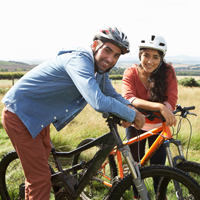
As the temperatures continue to rise, we have decided to put together a few hot weather exercise tips to consider while staying active and for staying hydrated through the summer.
Set your alarm: Sunrise is generally the coolest time of day, so get up and get out early. It may be more humid, but it is generally still hot at sunset because the ground radiates accumulated heat.
Hydrate: It is recommended to drink at least eight ounces of liquids prior to heading outside to exercise and 6-8 ounces of fluids every 15 minutes, switching between water and an electrolyte drink. Remember to drink plenty of fluids post-exercise to speed recovery.
- Remember to drink water and other fluids throughout the day. Carry a water bottle with you or grab a drink each time you pass a water fountain.
- Drink 16oz of fluid 2-3 hours before exercise
- Drink an additional 10oz of fluid 10-20 minutes before exercise
- Consume 20-40oz of fluid for every hour of exercise
- Always have water available. Take a bottle to work, the gym or wherever you are headed, and remember to use it.
- Drink up any time you are in the sun. Just being outside can lead to dehydration
- Children and the elderly are more susceptible to dehydration
- Finally don’t rely on thirst as a signal to drink water. Thirst is actually a sign that the body is under stress and by the time you feel thirsty, dehydration has already begun to set in. Other symptoms of dehydration include dry mouth, irritability, headache, weakness, dizziness, cramps, nausea, and fatigue. Even mild dehydration can lead to diminished performance, the elevation of core body temperature, and increased cardiovascular strain.
Acclimatize: It is advisable to gradually build up your tolerance for exercising in warmer conditions
Wear Technical Fabrics: Technical fabrics wick sweat from your body to keep you cool. Also, wear a visor to keep the sun out of your eyes, not a hat, which traps the heat.
Slow Down: For every 5-degree rise in temperature above 60 degrees F, slow down your activity intensity by 5%
Protect: Use sunscreen to protect your skin and prevent sunburn.
Be realistic: Do not overestimate your level of physical fitness; set realistic exercise goals.
What happens if I feel pain after a workout?
Keep in mind that even when you follow these hot weather exercise tips, some discomfort and muscle soreness is to be expected. If your pain does not resolve within a few days, that is when it’s time to ask for help. Your body may be able to accommodate your pain for a short period, but if left alone, you may begin to experience weakness, a lack of flexibility, and even additional injury if your body moves to avoid the pain by overcompensating with other muscle groups. The sooner you ask for help the better. During your physical therapy first visit, we will evaluate your injury and from there we can:
- Alleviate pain
- Correct improper movement patterns
- Correct muscle imbalances through flexibility and strength training
- Modify training when possible
- Educate you about faulty or improper posture or body mechanics with training






















